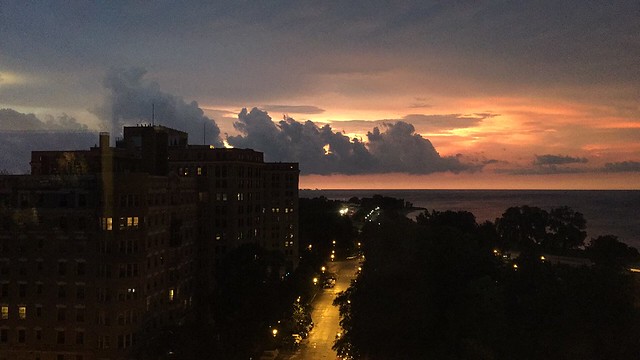
As usual in the Midwest, summer has brought a relentless series of watches and warnings, including thunderstorms, severe weather, flooding, and tornadoes. When a new watch or warning is issued or a current one is updated, one of my phone’s weather apps emits a submarine sound. Sometimes I feel like I’m immersed in Voyage to the Bottom of the Sea.
Not that long ago, before mobile phones, weather apps, and 24/7 cable, people got their weather news and updates from regularly scheduled radio and television news. Emergencies might warrant a crawl across the TV screen with a siren or very loud beeping. Basic, everyday weather news at 6 and 11 wasn’t enough for my dad, however. He tuned into his dedicated weather radio.
A weather radio picks up NOAA broadcasts that include arcane weather details you won’t hear on the 6 o’clock news, which you may not watch anyway because you get the news from trending topics on Facebook and Twitter. I hadn’t heard a weather radio broadcast in decades, but I remember a flat, tinny male voice, most likely not a “voice talent,” reciting a long list of current weather conditions and statistics in a monotonously soothing way. My dad could listen to this for long periods, as though he were a farmer whose livelihood depended on knowing weather conditions intimately and preparing for them. Our weather radio did come in handy a few times, such as during the Western New York Blizzard of ’77. We kept spare batteries on hand for all of our radios because we never knew when wind or ice would knock out the power.
Today I imagine a weather radio may be useful to boaters, campers, hunters and fishers, construction foremen, and anyone else whose life or work might depend on unexpected or sudden changes in weather conditions. Several years ago in Chicago, a horrendous thunderstorm with hail abruptly blew in without warning, even breaking thousands of panes of glass at Garfield Park Conservatory. If I were out on Lake Michigan in a small craft, I would have wanted to know about those black clouds darkening the western sky, how conditions were changing, and how long I would have to row my boat ashore.
Here’s a little more about these broadcasts:
NOAA Weather Radio is a 24 hour a day…7 day a week continuous broadcast of weather information. With the touch of a button, the current conditions, 7 day forecast, and other pertinent weather information is available whenever you want it. More importantly is the ability to get severe weather information the moment it is issued. Most weather radio models have an alert feature that will be activated to alarm you of any watch or warning issued for your area. Many have SAME technology that will only alert you for the county (or counties) you are interested in.
Weather radio came into being in 1972, and was designated by the White House as the sole government-operated radio system to provide direct warnings into private homes for both natural disasters and nuclear attack. This concept has been expanded to included warnings for all hazardous conditions that pose a threat to life and property.
As I said, once upon a time, the voice belonged to humans — as it turns out, the updates were recorded by staff at local National Weather Service offices, nearly all of them male. Although the voices varied, they were reassuring in their lack of voiceover-style sophistication. Today, however, the voices are synthesized. “Tom” comes closest to my memories, but still he doesn’t quite evoke morning at the kitchen table, listening to the weather radio.
Of course weather radios aren’t truly a relic. Not only can you still buy them, but there are even a number of options in a surprisingly broad range of prices (my brief search showed roughly $25 to $60, or $75 with a lithium battery). Copy for my favorite, no longer available, says: “If you’re in an area prone to occasional violent weather (and what area isn’t?) this radio can be a lifesaver.” I’m tempted.
If you have a weather radio, here’s where you can find your local weather station. Chicago’s is KWO39 at 162.550, broadcasting from Romeoville in the southwest suburbs via a transmitter at the “Sear’s Tower” (someone needs to tell NOAA it’s now Willis Tower).
Will your eight-year-old son or daughter wax nostalgic over iffy mornings and evenings or camping trips spent listening to “Tom” or whatever synthesized voice supplants him? For myself, “Tom” doesn’t evoke strong feelings or tempt me to buy that spiffy weather radio after all. I guess I’ll just have to keep feeling like I’m aboard the Seaview.

UPDATE 7/29/2016: After the skies turned dark again, I compromised and spent $4.99 on a weather radio iPhone app. Still not the same as the radio on the kitchen counter.
